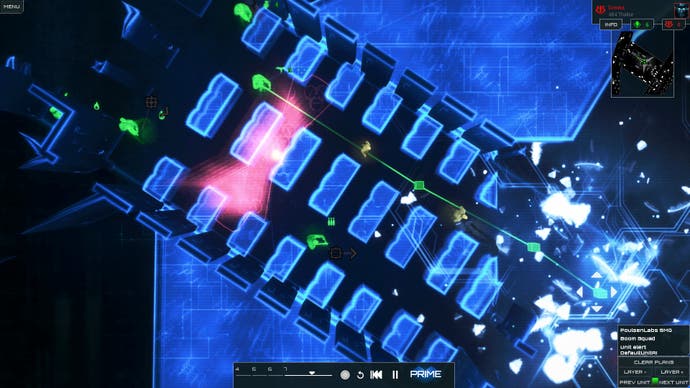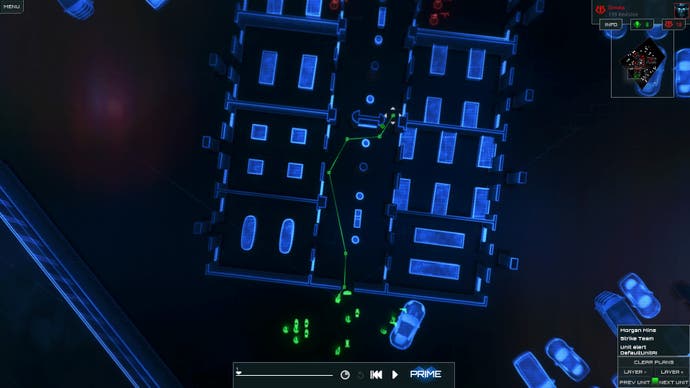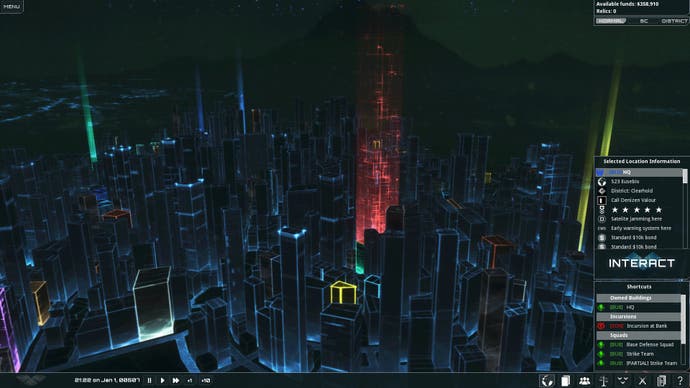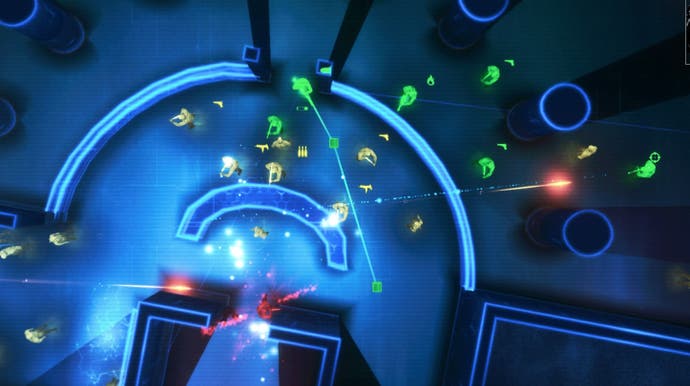Frozen Synapse 2 review - sharp tactical shenanigans in a fractious cyber-city
Virtual light.
What did you do during the incursions? When the city was under threat from within and without, when the petty, tooled-up factions were bristling and looking for any excuse to kick off, and then every few minutes they would burst through cyberspace (or whatever it is) at a new location and initiate a major scuffle?
Well, I delivered a lot of packages.
In Frozen Synapse 2 it is surprisingly easy to find yourself skint: factions disappointed in you and cutting funding, easy jobs neglected because urgent matters got in the way. For my first few games, my finances were constantly tanking, which meant I couldn't hire enough talent to get me through even the simplest combat mission, which in turn meant that I couldn't receive regular cash injections from taking on the simplest combat missions in the first place - defence contracts, venture prevention. I was behind the power curve. So instead, I had to go to the absolute lowest paying, least dangerous fare imaginable. I had to effectively throw away my early-game hopes and become a parcel courier. I was hired, originally, to hold this city together, and yet here I am taking boxes around and dropping them off. How brilliant! No, seriously. How deeply brilliant that this glittering neon cyberpunk affair should have plenty of room to explore an emergent gig economy. It's not really a dystopia until someone's left you a little postcard saying that the goods you ordered are with a non-existent neighbour.
The original Frozen Synapse was a tactical battler that hinged on a sort of double-blind idea. (I may be using that term incorrectly.) It was red against green, different units, different capabilities, facing off against each other in maps made from blades of cool neon, all delivered with a brilliant twist: you made your move while your enemy made their move. Neither party could see the other's machinations until both committed to the turn, at which point both sides' actions would unfold simultaneously.

The genius of this was that when it worked - when you successfully anticipated an enemy's move - it was a truly dazzling high. Maybe you cranked the simulation, plugging in not just your own movements but your best guess at what your enemy was doing. Maybe instead you opted for the tactical battler's take on the Three H approach, and just pushed ahead aggressively and assumed your foe would do the same. Whatever. To get your shotgunner in just the right position to take out their SMG as it rounded a corner, oblivious to your presence, was just about the sweetest pleasure tactical gaming could offer, as if ghostly dimensions were colliding, bullets passing through these strange membranes as deeply personal timelines kissed against one another.
And when it didn't work, well, it was still great, because Laurel and Hardy took over. Both sides would stalk phantoms across the map, bravely moving in on empty hallways and getting the drop on dusty broom closets. Rivals would pass by in the same battle arena, almost clipping through each other but failing to open fire, because the opposite of anticipation had occurred. God, it was fun.
Frozen Synapse 2 takes this beautiful core - not just the moving, but the ability to test an enemy's potential movements against your own before commiting to a turn - and builds a far more fully-realised campaign around it. You're now one faction amongst many in a luminous neon cityscape. You're tasked with keeping the peace, I think - these factions are itching for an excuse to launch ventures against one another - and you're also dealing with those incursions. These are attacks from outside the city that provide a common threat to all factions, but are also a source of opportunity, because the game ultimately hinges on collecting a set number of relics, the same little doodads that the incursion forces are after. It's not just enough to get a relic, mind. You have to get it back to your base and activate it. Meanwhile, who knows who will come after you for it while it's still up for grabs?
What this boils down to, as far as I play it, is a gloriously shrill hymn to what economists call opportunity cost. (I may be using this term incorrectly too.) Whatever you're doing at any moment, you should really be doing something else. The game is terribly good at telling you all this stuff. If you go after incursions, you're probably not doing favours for the various factions to keep them sweet and keep your funding coming in. If you're doing favours for the various factions, you're probably letting other factions go after the incursions. And, of course, a favour for one faction is a favour that has gone against rival factions. It is a bit like being the child of divorced parents at Christmas.

Or, if you're me, you're basically managing a cyberpunk version of Uber Eats, which means that the factions are running wild and you're still not making enough money to pad out your squads with fresh mercenaries, coming in all the usual flavours - flamethrowers, SMGs, assault rifles, pistols, knives, that kind of jazz. Sometimes, it takes a game of crypto-babble and elbowy Gibsonian neologisms to truly drive home just what happens when you fall a little behind and find that everything you're doing to bring in a little money just makes it worse.
The detailing is lovely. The factions are all gloriously unpleasant, futuristic megacorp naming conventions linked to characterful leader portraits that suggest a world of glittering pettiness and brutal smuggery. Regardless of the specific underlying ethos, these are people united by a delight in being disappointed, I think, and they absolutely love the opportunity to turn down an offer to increase your standing with them. The city, meanwhile, is a tantalising place to battle over as you zoom in and out of its skyscrapers and flowing tributaries. It's a metropolis that endlessly chucks problems your way - every few seconds the action pauses as another request comes in, or another atrocity makes the uneasy peace a little uneasier still. And then there's the question of what you should be doing - buying another base, taking on missions to earn a bit of extra cash and favour, hunting through the markets for decent mercenaries. If you are truly blessed, you may even find the time and resources to keep an eye on who is running low on money and might be a target for taking out - kill the faction leader and the corporation is gone, even if they still survive to play a ghostly role in the campaign story - and who is stockpiling relics.
Or you can just sit back, stunned and overwhelmed and preemptively defeated, and watch the city grinding on. Territory shrinking and growing. Faction squads racing back and forth on busy, beetling duties. Red flares of incursions erupting. God, I should really try to sort some of those out, shouldn't I? The city looks beautiful, but it's also something of a design marvel: each building, each road intersection, can become a combat arena when you take on a mission and when the tactical double-blind stuff takes over. The maps are a mixture of procedural elements and pre-designed assets, and there is a lovely bit of showmanship when you arrive at a location for a mission and the camera swoops in overhead and then plunges down to street level. Whether it's a superscraper you're assaulting or an intersection your patrol is defending, the game copes with the interaction of its two modes rather elegantly: the tactical stuff makes sense alongside the strategic layer.
And a handful of mission types vary things nicely. The AI is fun - Its various pieces are wonderfully aggressive even if I didn't always get the sense that units worked in concert that meaningfully - and it makes for some wonderful Petri dish moments. In one mission I spawned in the middle of the map and had to hold out for 30 seconds while enemies and reinforcements rushed in from all sides. The game would pause between turns when there were bullets flying through the air, and even though I literally had forever until I had to make my next move, the sense of pressure was so intense I would invariably make a muddle of it, suggesting that units crouch when there was no cover, and sending knives in against assault rifles, head-on. Never a good idea.

It's surprisingly good at stories, this game. Small, battlefield stories. My first real win involved holding back. I was in a long, thinnish kind of map - some kind of building complex at one end and a massive expanse of car parking at the other. The bulk of my enemies were clustered in the middle, red figures pulled so tightly together I had to zoom in close to see the weapons: pistols, mainly, and a few knives. I positioned myself at the end of the car park, there were three of us, and we crouched behind bumpers. Massively outnumbered. Then, instead of advancing and moving from one piece of cover to the next, we just waited, picking enemies off whenever they wandered too far from the pack. It was a victory for Parcel Force, although it hardly felt heroic. When the main bunch of enemies were taken out I inched up on the heavy units stationed in a compound near the street and finished them off with a single grenade. I don't think they even saw me. The postman truly rang twice that day.
If this all sounds too much - and on my third or fourth game, I'm still feeling a little lost, in a pleasant way, in amongst the myriad demands of the campaign - you can still play Frozen Synapse the old-fashioned way. This is one of those games that I'll never feel I've played enough to get the true measure of, but I suspect the longest life it has may ultimately reside in the multiplayer menu, where you can find a match amongst a player-base that seems relatively willing at present and do the old play-by-mail thing, with the game running in the background while messages that it's your turn pop up. It feels like a wonderfully old-fashioned and polite way of engaging with such a brutal piece of SF.
(The Dark mode rules here, by the way: enemies effectively disappear when line of sight is broken. As a result, my favourite multiplayer matches so far have been a bit like submarine hunts: where and when will my foes resurface? Then there's OneTurn, in which you fight through wave after wave of horribly claustrophobic combat scenarios. Lovely!)
All taken together, it's a pretty wonderful thing: a complex, gloriously mean-spirited fight for the city with hundred of thousands of little turn-based shootout puzzles waiting for you whenever you fancy them. There's always something else you should be doing, of course, but even doing the wrong thing feels pretty good here.


